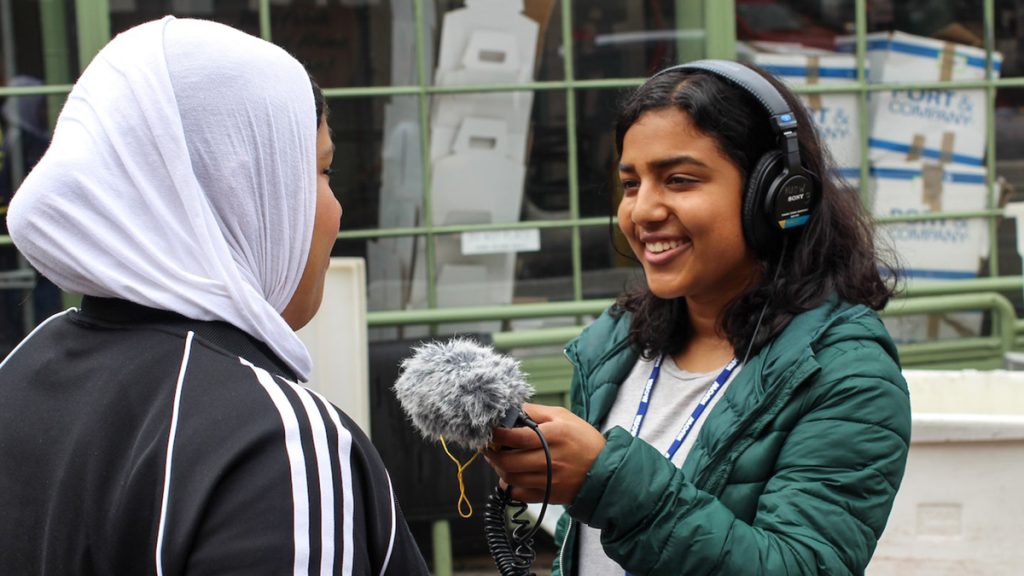
Ritika Managuli (right), a youth producer with RadioActive Youth Media at KUOW Public Radio, practices interviewing skills at Pike Place Market in Seattle, Washington on July 10, 2019. Credit: Kelsey Kupferer
How to build a youth journalism program that benefits your newsroom
Six considerations for youth media program development
Offering youth media opportunities to young people in your community — be it an hour-long storytelling workshop for curious fifth graders or a months-long internship program for dedicated high schoolers, can positively influence your staff, your audience, your reporting, your community, and the future of your newsroom.
But youth journalism programs only benefit youth and your newsroom when they’re designed thoughtfully, and when they make youth safety and well being their top priority.
With that in mind, here are six considerations for anyone planning to start or expand a youth media program in their newsroom:
1. Equity and accessibility
Strong youth journalism programs minimize the barriers to access that keep marginalized people out of newsrooms, and create learning environments where all youth can thrive.
What you can do
- Offer the journalism programs free of cost to youth and families in your area.
- Pay youth for their time, especially when they support reporters or produce content for your newsroom.
- Prioritize working with youth who do not already have access to robust arts and media programs, such as those who go to schools without journalism classes, live in areas with limited resources, are part of immigrant and refugee families, are part of low-income earning households, and/or youth who are incarcerated.
- Provide participating youth with the things they need in order to participate fully, such as meals, snacks, public transportation passes, office supplies, fidget toys, captions and transcripts, interpreters, laptops, headphones, smartphones, and internet hotspots.
- Build relationships with the parents, guardians, and supporters of the participating youth, including translating program documents into the language families speak at home, and keeping trusted adults informed about the progress of projects their youth are working on.
- Keep the barriers to success for marginalized people in newsrooms – like racism, exploitation, low pay, and community mistrust – top of your mind, and work seriously to address them within your newsroom. We often turn to Media 2070 and Public Media for All as starting points.
2. Safe and supportive environment
A high-quality youth journalism program makes their safety and wellbeing its top priority. Anything less can seriously harm those who participate in your program.
A safe and supportive program environment is also essential for their social and emotional learning. For young people, building social and emotional skills like self-confidence and empathy – at the same time as they build journalism skills – will result in their success in your newsroom’s program, and also the strongest possible affinity between the youth, the newsroom, and local news media as a whole.
What you can do
In order to build and maintain a safe and supportive environment, everyone who works with youth must be trained in safety best practices, and the safety and quality of your program should be regularly assessed.
- For training materials on safe interactions, we love the Youth Program Best Practices from the University of Washington.
- For youth program planning and assessment, we love the Program Quality Assessments (PQA) from the David P. Weikart Center for Youth Program Quality. The Youth Program Quality Assessment (YPQA), which is for programs serving youth in grades 4-12, breaks down program elements like Engagement, Emotional Safety, and Belonging, and you can download the YPQA assessment tool for free.
- If you’re leading online-only or hybrid in-person/online youth programs, we also love Leading Groups Online, a really wonderful guide to building supportive spaces virtually by Jeanne Rewa and Daniel Hunter.
3. Mentorship
Mentorship is key to student recruitment, retention, and success in youth journalism programs. Mentors offer encouragement, facilitate belonging, and look out for youth wellbeing, in addition to providing expertise from their experience in the field. A mentorship structure also offers a path to employment for participants after they have graduated from the program.
What you can do
- Utilize adult mentors: Pair participating youth with a (paid and trained) adult mentor who has experience in both journalism and working with youth.
- Mentors work especially well in longer-term youth journalism programs where youth are producing their own work over a period of weeks or months. Mentors can work alongside youth daily, and offer all types of personal and professional support, including helping youth shape their stories, prepare for interviews, and stay on track to meet deadlines.
- Mentors who share the identities and lived experiences of the youth they’re working with are often the most effective.
- Utilize peer and near-peer mentors: Once you have youth who have gone through your youth journalism program, you can start to employ them as peer mentors! In our experience, youth are uniquely receptive to mentorship from their peers and near-peers who have been through youth journalism workshops previously, and can share their lived experience.
4. Youth voice
Young people’s perspectives are as valuable as adults’ – that’s what youth media is all about. And so it follows that youth leadership is critical in a youth-serving program.
What you can do
- Ask for youth feedback in different ways at the end of every workshop, and implement that feedback as much and as quickly as possible.
- We recommend gathering a combination of formal (such as end-of-workshop surveys) and informal feedback (such as regularly checking in with youth).
- We also recommend asking a combination of specific questions (such as, “Did you learn something new about script writing today?”) and open-ended questions (such as, “When we do this workshop again next year, what should change, and what should say the same?”).
- Pay youth to serve on youth program and/or newsroom leadership teams, such as strategic planning teams.
5. Creativity and play
Youth journalism programs can be ‘playgrounds’ where young people who are new to the medium take risks, make mistakes in a safe and supportive environment, and discover new ways of producing compelling stories.
What you can do
- Introduce youth to many different types of non-fiction storytelling, including creative nonfiction, narrative nonfiction, multimedia storytelling, social media storytelling, and documentary.
- Ask youth what the news would look like if they had total control. Then see if they can make it happen.
- Remind youth (and your newsroom) that content produced by youth will be different from content produced by adults in your newsroom, and that’s a good thing! Youth-produced content can be creative while still adhering to your newsroom’s standards for rigorous newsmaking.
- For example, this award-winning story from RadioActive Youth Media uses only sound – no words – to tell a non-fiction news story from the pandemic.
- Offer opportunities for youth to explore storytelling outside of the traditional newsroom format, such as by completing one of the activities from Sarah Geis’ Audio Playground or from the San Francisco Museum of Modern Art’s Learning to Love You More creative assignment list.
6. Paths upward
Youth journalism programs have the potential to create strong bonds between participating youth and the local newsrooms who host them, planting the seeds for future audience members, supporters, newsmakers, and community leaders.
Once youth have connected with your newsroom through a youth journalism program, it’s beneficial for everyone if they are able to continue to stay involved.
What you can do
- Provide leadership and employment opportunities to program graduates, such as paid roles as youth program mentors, strategic planning contributors, and/or newsroom advisory council or board members.
- One of the biggest successes? Hiring someone who participated in your youth program into a full-time role at your newsroom. And it’s possible! KUOW Public Radio in Seattle, Washington, which has supported a year-round youth media program for almost 20 years, currently employs four full-time staff members who got their start in KUOW’s youth program as teens.
Are you thinking about starting a youth-focused program at your newsroom, but don’t know where to start? We’re here to help. Sign up here to connect with us, and be the first to receive our youth journalism program starter guide.

